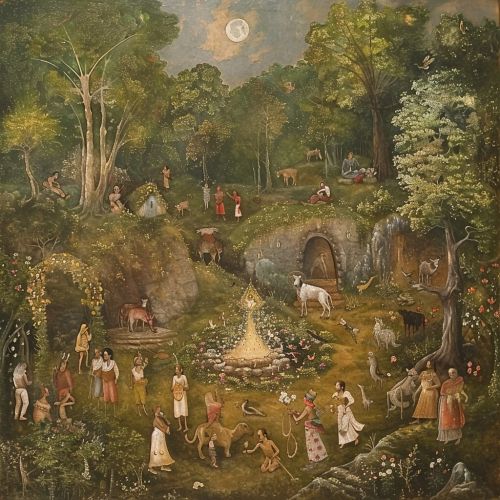Animism
Overview
Animism is a religious belief that objects, places, and creatures all possess a distinct spiritual essence. Potentially, animism perceives all things—animals, plants, rocks, rivers, weather systems, human handiwork, and perhaps even words—as animated and alive. This belief system is used in various forms in many cultures, and is a fundamental aspect of many indigenous peoples' cultures and belief systems.


Etymology
The term "animism" is derived from the Latin word "anima", meaning "breath, spirit, life". The term was first used in the context of religious beliefs by the anthropologist Sir Edward Tylor in his 1871 book "Primitive Culture", in which he defined it as "the general doctrine of souls and other spiritual beings in general." Tylor's definition of animism was a part of a growing international debate on the nature of "primitive society" by lawyers, theologians, and philologists.
Historical Development
The idea of animism was developed by the anthropologist Sir Edward Tylor in his 1871 book "Primitive Culture", in which he defined it as "the general doctrine of souls and other spiritual beings in general." According to Tylor, animism often includes "an idea of pervading life and will in nature"; a belief that natural objects other than humans have souls. He argued that this led to the belief in spirits, gods, and the afterlife. His theory of "primitive animism" was further developed by other anthropologists, such as Alfred Wallace and James Frazer.
Beliefs and Practices
Animism encompasses a wide range of beliefs. However, there are common themes that are shared among those who adhere to this belief system. Most notably, animism often includes "an idea of pervading life and will in nature"; a belief that natural objects other than humans have souls. This can manifest in beliefs in spirits, gods, and the afterlife.
Animistic practices vary widely, as they are often specific to the culture and environment in which they are practiced. However, they often involve rituals and ceremonies designed to interact with, appease, or manipulate the spirits believed to inhabit the world around them. These can include offerings, dances, songs, and other forms of communication with the spirit world.
Animism in Different Cultures
Animism is found in many indigenous cultures around the world, from the Native American tribes of North America to the Aboriginal peoples of Australia. It is also found in many African, Asian, and South American cultures. Each of these cultures has its own unique form of animism, shaped by the local environment, history, and societal structures.
For example, in many Native American cultures, animism is expressed through a belief in "spirit beings" that inhabit the natural world. These spirits are often associated with specific animals, plants, or natural phenomena, and are believed to have the power to influence the world around them.
In many African cultures, animism takes the form of a belief in spirits that inhabit natural objects, such as trees, rocks, and rivers. These spirits are often seen as ancestors or nature deities, and are venerated through rituals and offerings.
Criticism and Controversy
The concept of animism has been criticized by some scholars for its perceived ethnocentrism and its use as a tool of colonialism. Some argue that the term "animism" is a Western construct that does not accurately represent the beliefs and practices of indigenous cultures. Others argue that the concept of animism has been used to justify the colonization and exploitation of indigenous peoples by portraying their beliefs as "primitive" or "superstitious."
Despite these criticisms, the concept of animism continues to be used in anthropological and religious studies. Some scholars argue that, despite its flaws, the concept of animism can provide a useful framework for understanding the diverse beliefs and practices of indigenous cultures.
